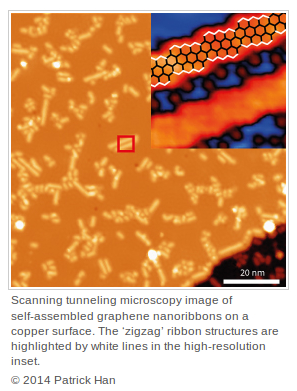Japanese researchers at Tohoku University have recently found that a surface-assisted chemical reaction provides unprecedented control over graphene nanoribbons for future nanodevices.
The AIMR (Advanced Institute of Materials Research) research team, led by Prof. Patrick Han and Prof. Taro Hitosugi, has discovered a fundamentally new (bottom-up) manufacturing method for defect-free graphene nanoribbons (GNRs) with periodic zigzag curves.
Copper is more suitable than gold or silver substrates
In order to synthesize zigzag nanoribbons, the researchers tried to find out whether a reactive copper surface could guide a molecular polymerization reaction. According to Professor Han, molecules should be less free on surfaces such as copper than when gold or silver substrates are used. They diffuse randomly and are more likely to interact with an ordered lattice of metal atoms.

In contrast to previous experiments, the current method has produced shorter bands, only in six surface azimuthal directions. This feature can be used for the fabrication of simple graphene connections between prefabricated structures by self-assembly.
Further information on the interesting research results can be found in the university's press release at the following URL.

